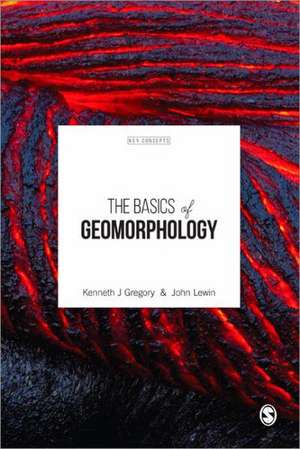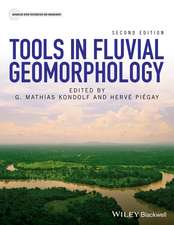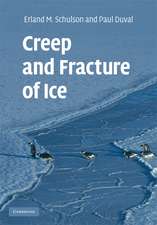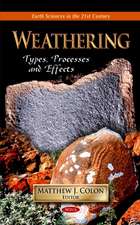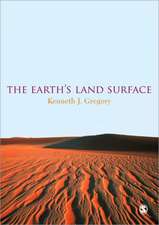The Basics of Geomorphology: Key Concepts
Autor Kenneth J. Gregory, John Lewinen Limba Engleză Paperback – 12 noi 2014
- Victor R. Baker, University of Arizona
"A very readable and informative introduction to the discipline for senior undergraduates, postgraduates and researchers."
- Angela Gurnell, Queen Mary University of London
"Time will tell, but this book may well mark a turning point in the way students and scientists alike perceive Earth surface processes and landforms."
- Jonathan Phillips, University of Kentucky
This student focused book provides a detailed description and analysis of the key concepts, ideas, and hypotheses that inform geomorphology.
Kenneth Gregory and John Lewin explain the basics of landform science in 20 concepts, each the subject of a substantive, cross-referenced entry. They use the idea of the 'geomorphic system' to organise entries in four sections, with extensive web resources provided for each:
- System Contexts: The Systems Approach / Uniformitarianism / Landform / Form, Process and Materials / Equilibrium / Complexity and Non Linear Dynamical Systems
- System Functioning: Cycles and cascades / Force-Resistance / Geomorphic work / Process Form Models
- System Adjustments: Timescales / Forcings / Change Trajectories / Inheritance and Sensitivity / Anthropocene
- Drivers for the Future: Geomorphic Hazards / Geomorphic Engineering / Design and Prediction
| Toate formatele și edițiile | Preț | Express |
|---|---|---|
| Paperback (1) | 244.94 lei 3-5 săpt. | +13.95 lei 6-12 zile |
| SAGE Publications – 12 noi 2014 | 244.94 lei 3-5 săpt. | +13.95 lei 6-12 zile |
| Hardback (1) | 762.26 lei 6-8 săpt. | |
| SAGE Publications – 13 noi 2014 | 762.26 lei 6-8 săpt. |
Preț: 244.94 lei
Nou
Puncte Express: 367
Preț estimativ în valută:
46.87€ • 50.12$ • 39.08£
46.87€ • 50.12$ • 39.08£
Carte disponibilă
Livrare economică 28 martie-11 aprilie
Livrare express 13-19 martie pentru 23.94 lei
Preluare comenzi: 021 569.72.76
Specificații
ISBN-13: 9781473905757
ISBN-10: 1473905753
Pagini: 248
Dimensiuni: 156 x 234 x 13 mm
Greutate: 0.36 kg
Ediția:1
Editura: SAGE Publications
Colecția Sage Publications Ltd
Locul publicării:London, United Kingdom
ISBN-10: 1473905753
Pagini: 248
Dimensiuni: 156 x 234 x 13 mm
Greutate: 0.36 kg
Ediția:1
Editura: SAGE Publications
Colecția Sage Publications Ltd
Locul publicării:London, United Kingdom
Recenzii
Although there are many introductory geomorphology books, this latest contribution from Professors Gregory and Lewin is an excellent addition to the genre. They ask fundamental questions on the nature of scientific enquiry in geomorphology, on the burgeoning field of complexity studies and its interface with traditional geomorphological questions, and on the ways in which geomorphic processes relate to real world problems. The chapter on the Anthropocene illustrates well the variety of perspectives that geomorphologists have on this latest theme in geomorphology. The book is replete with boxes, web sites and recommendations for further reading. I would have appreciated having a copy of this book when I taught the introductory and follow-up geomorphology courses.
As Geomorphology has matured as a discipline, so it has developed a range of concepts which are fundamental for understanding it. This book, written by two leading geomorphologists, provides a very welcome first attempt to explain the major concepts in a concise and accessible way.
Geomorphology and Earth sciences in general have been profoundly transformed by ideas that expand our vision from “normal” or “equilibrium” forms and developmental pathways (with exceptions to the pattern treated as deviations) to a much richer vision. The latter recognizes multiple possible pathways and outcomes, and landscapes and landforms that encompass, but transcend, classical equilibrium notions. Basics of Geomorphology is to my knowledge the first and only geography or geology textbook that fully embraces this new vision. Gregory and Lewin have managed the difficult but important task of distilling a new set of “basics” from these revolutionary insights that both broadens and complements traditional ideas. This book is remarkable in the way that it acknowledges a wonderful plurality of conceptual frameworks and approaches, and explains them in a clear, engaging way. Time will tell, but this book may well mark a turning point in the way students and scientists alike perceive Earth surface processes and landforms.
This book provides a very accessible overview of the discipline of geomorphology that is well supported by web-based material. The text is up-to-date, with excellent reference to relevant literature, and presents the discipline in an interesting and novel way. It provides a very readable and informative introduction to the discipline for senior undergraduates, postgraduates and researchers approaching the subject from other areas of science.
In the current millennium humans have reached a critical point for coping with the surface of their planet, including its changing climate and environments, the alarming vulnerability to its hazards, and the increasingly complex problems of sustainability. All of these interrelated concerns require renewed attention to geomorphology, the science that deals with Earth’s land surface and the processes that operate thereupon. I can think of no better guides than Professors Ken Gregory and John Lewin to lead the reader through the conceptual basis of this exciting science, as they do in their new book: The Basics of Geomorphology: Key Concepts. I highly recommend this book to those wishing for an up-to-date introductory overview of this rapidly changing science that is so critical to preserving the continuing habitability of our planet.
‘Geomorphologists often struggle to understand and see the relevance of philosophy. This book provides an ideal introduction to geomorphological concepts packaged in a user-friendly and non-threatening way’.
At a time when Earth’s surface is changing rapidly, a geomorphology text centering on systems concepts, including interactions and adjustments, is especially timely. While grounded in key concepts of the discipline, this text prepares students for confronting new challenges ahead, including increasing human interactions in the “Anthropocene.”
Understanding geomorphologic concepts has become more important in recent years given the increase in various environmental issues. Gregory (president, British Society for Geomorphology) and Lewin (formerly, Aberystwyth University) have written a useful, moderate-sized textbook on the subject supported by an extensive companion website. The website contains PDF files of each chapter,including tables and diagrams, chapter synopses, and citations from Progress in Physical Geography that are not available in the book. The site also contains an extensive list of references (50-plus-pages)and a glossary. This very readable book and the easily accessible website greatly facilitate learning and understanding of this important topic in geology.
Its focus is the core principles of geomorphology. It is an impressive survey of the philosophy and historiography of the discipline, with dense and readable introductions to topics as diverse as cycles, landforms, uniformitarianism, the Anthropocene, and geomorphic hazards... This thought-provoking book is an anchor for serious students who are seeking those skills, afloat in the internet age.
As Geomorphology has matured as a discipline, so it has developed a range of concepts which are fundamental for understanding it. This book, written by two leading geomorphologists, provides a very welcome first attempt to explain the major concepts in a concise and accessible way.
Geomorphology and Earth sciences in general have been profoundly transformed by ideas that expand our vision from “normal” or “equilibrium” forms and developmental pathways (with exceptions to the pattern treated as deviations) to a much richer vision. The latter recognizes multiple possible pathways and outcomes, and landscapes and landforms that encompass, but transcend, classical equilibrium notions. Basics of Geomorphology is to my knowledge the first and only geography or geology textbook that fully embraces this new vision. Gregory and Lewin have managed the difficult but important task of distilling a new set of “basics” from these revolutionary insights that both broadens and complements traditional ideas. This book is remarkable in the way that it acknowledges a wonderful plurality of conceptual frameworks and approaches, and explains them in a clear, engaging way. Time will tell, but this book may well mark a turning point in the way students and scientists alike perceive Earth surface processes and landforms.
This book provides a very accessible overview of the discipline of geomorphology that is well supported by web-based material. The text is up-to-date, with excellent reference to relevant literature, and presents the discipline in an interesting and novel way. It provides a very readable and informative introduction to the discipline for senior undergraduates, postgraduates and researchers approaching the subject from other areas of science.
In the current millennium humans have reached a critical point for coping with the surface of their planet, including its changing climate and environments, the alarming vulnerability to its hazards, and the increasingly complex problems of sustainability. All of these interrelated concerns require renewed attention to geomorphology, the science that deals with Earth’s land surface and the processes that operate thereupon. I can think of no better guides than Professors Ken Gregory and John Lewin to lead the reader through the conceptual basis of this exciting science, as they do in their new book: The Basics of Geomorphology: Key Concepts. I highly recommend this book to those wishing for an up-to-date introductory overview of this rapidly changing science that is so critical to preserving the continuing habitability of our planet.
‘Geomorphologists often struggle to understand and see the relevance of philosophy. This book provides an ideal introduction to geomorphological concepts packaged in a user-friendly and non-threatening way’.
At a time when Earth’s surface is changing rapidly, a geomorphology text centering on systems concepts, including interactions and adjustments, is especially timely. While grounded in key concepts of the discipline, this text prepares students for confronting new challenges ahead, including increasing human interactions in the “Anthropocene.”
Understanding geomorphologic concepts has become more important in recent years given the increase in various environmental issues. Gregory (president, British Society for Geomorphology) and Lewin (formerly, Aberystwyth University) have written a useful, moderate-sized textbook on the subject supported by an extensive companion website. The website contains PDF files of each chapter,including tables and diagrams, chapter synopses, and citations from Progress in Physical Geography that are not available in the book. The site also contains an extensive list of references (50-plus-pages)and a glossary. This very readable book and the easily accessible website greatly facilitate learning and understanding of this important topic in geology.
Its focus is the core principles of geomorphology. It is an impressive survey of the philosophy and historiography of the discipline, with dense and readable introductions to topics as diverse as cycles, landforms, uniformitarianism, the Anthropocene, and geomorphic hazards... This thought-provoking book is an anchor for serious students who are seeking those skills, afloat in the internet age.
Cuprins
Introduction: Concepts and Geomorphology
SECTION A System contexts
The Systems Approach
Uniformitarianism
Landform
Form, Process and Materials
Equilibrium
Complexity and non linear dynamical systems
SECTION B System Functioning
Cycles
Force-Resistance
Geomorphic work
Process form models
SECTION C System Adjustments
Timescales
Forcings
Change trajectories
Inheritance
The ‘Anthropocene’
SECTION D Drivers for the Future
Geomorphic Hazards
Geomorphic Engineering
Prediction and Design
CONCLUSION
The Concept of Geomorphology
SECTION A System contexts
The Systems Approach
Uniformitarianism
Landform
Form, Process and Materials
Equilibrium
Complexity and non linear dynamical systems
SECTION B System Functioning
Cycles
Force-Resistance
Geomorphic work
Process form models
SECTION C System Adjustments
Timescales
Forcings
Change trajectories
Inheritance
The ‘Anthropocene’
SECTION D Drivers for the Future
Geomorphic Hazards
Geomorphic Engineering
Prediction and Design
CONCLUSION
The Concept of Geomorphology
Notă biografică
Descriere
Two globally respected geomorphologists explain the basics of landform science in 20 concepts. An accessible and student focused companion to the field.
